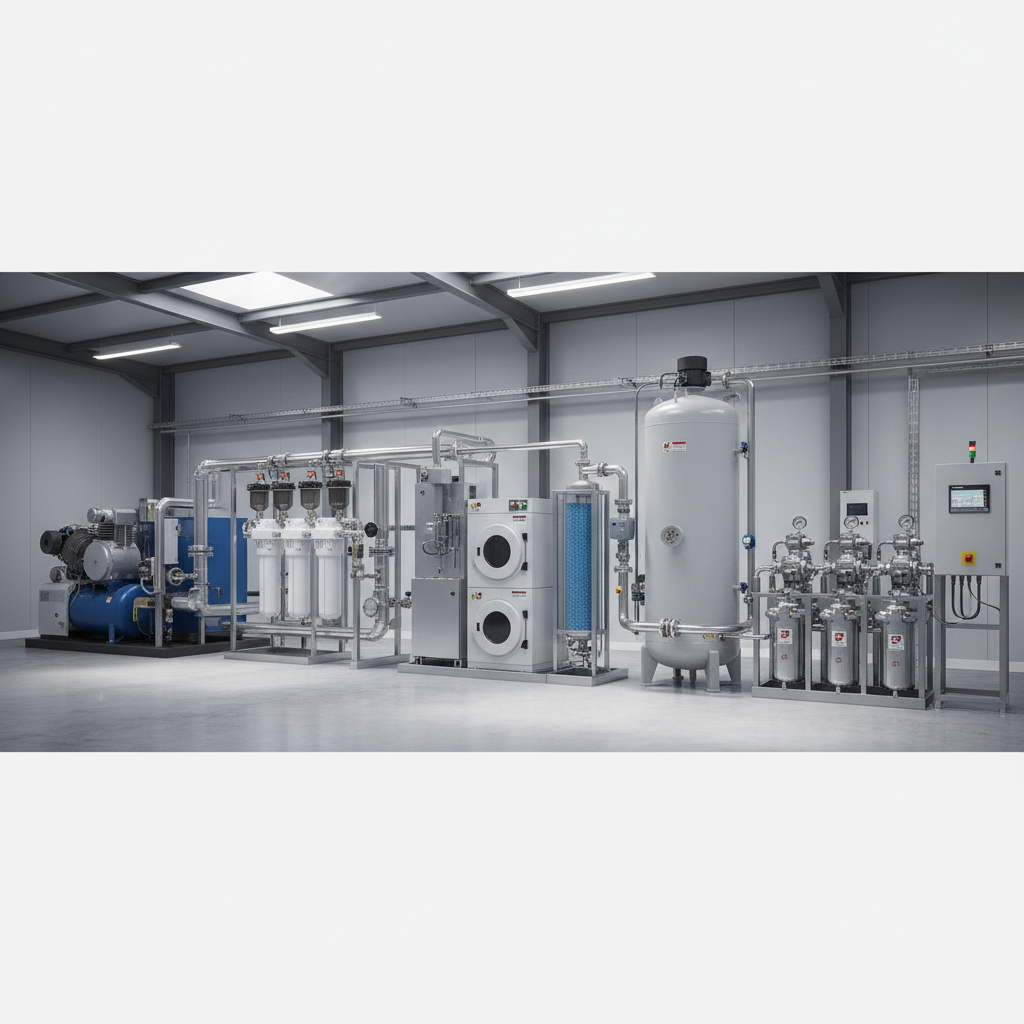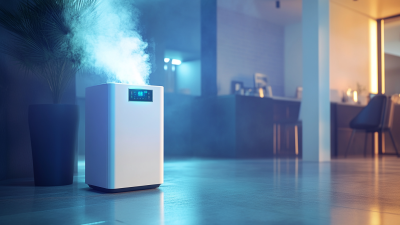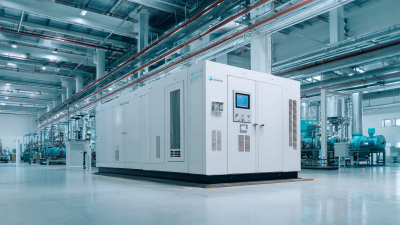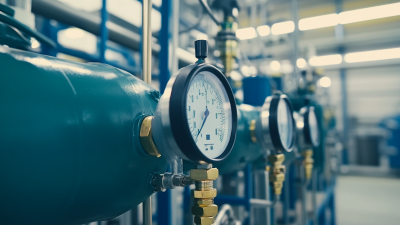
- sales@bjbod.com
- Mon - Sat at 7:00AM to 9:00PM

 Compressed Air Treatment plays a vital role in ensuring the efficiency and reliability of pneumatic systems across various industries. According to the Compressed Air and Gas Institute (CAGI), improper treatment of compressed air can lead to significant energy waste—around 30% of the system’s energy is often lost due to inadequate moisture and contamination management. Furthermore, a report from the U.S. Department of Energy emphasizes that compressed air systems account for about 10% of the total industrial electricity consumption, underscoring the importance of optimizing these systems for both cost and performance.
Compressed Air Treatment plays a vital role in ensuring the efficiency and reliability of pneumatic systems across various industries. According to the Compressed Air and Gas Institute (CAGI), improper treatment of compressed air can lead to significant energy waste—around 30% of the system’s energy is often lost due to inadequate moisture and contamination management. Furthermore, a report from the U.S. Department of Energy emphasizes that compressed air systems account for about 10% of the total industrial electricity consumption, underscoring the importance of optimizing these systems for both cost and performance.
As industries increasingly seek ways to reduce operational costs and enhance sustainability, understanding the essential aspects of Compressed Air Treatment becomes crucial. Poor air quality not only compromises equipment longevity but can also lead to product defects and increased maintenance expenses. Implementing effective treatment methods, such as filtration, drying, and conditioning, can significantly improve the overall efficiency of compressed air systems, ensuring they meet both performance standards and regulatory requirements. In this article, we will explore the top ten essential facts about Compressed Air Treatment that can help industries optimize their operations and achieve greater efficiency.
Compressed air treatment plays a crucial role in enhancing the longevity of equipment across various industries. Compressed air systems can often harbor contaminants such as water, oil, and dirt, which can significantly compromise the performance and lifespan of pneumatic machinery. Effective treatment systems, including filters, dryers, and separators, help eliminate these harmful substances, ensuring that only clean, dry air powers the equipment. By maintaining the quality of the compressed air, organizations can reduce wear and tear on machinery, resulting in fewer breakdowns and less frequent maintenance.
Moreover, a well-implemented compressed air treatment strategy contributes to operational efficiency. When equipment operates under optimal conditions, it can function more effectively, minimizing energy consumption and maximizing productivity. The reduction in compressor run times and maintenance schedules not only decreases operational costs but also extends the life of the air compressors themselves. By investing in proper air treatment solutions, businesses can create a more reliable production environment, ultimately leading to enhanced equipment longevity and increased profitability.
| Fact No. | Fact Description |
|---|---|
| 1 | Proper treatment of compressed air can extend the lifespan of pneumatic equipment. |
| 2 | Moisture control is essential; excess water can lead to corrosion and equipment failure. |
| 3 | Compressed air filters can remove particulates and contaminants, improving air quality. |
| 4 | Regular maintenance of air treatment equipment is crucial for optimal performance. |
| 5 | Using the appropriate dryer type can significantly enhance efficiency in compressed air systems. |
| 6 | Oil-free systems reduce the risk of contamination in products and processes. |
| 7 | Compressed air treatment can lower energy costs by improving system efficiency. |
| 8 | Proper sizing of air treatment equipment is essential to meet system demands efficiently. |
| 9 | Monitoring air quality can help identify issues before they impact equipment performance. |
| 10 | The integration of advanced technologies in air treatment can further enhance system reliability. |
Compressed air quality is governed by various industry standards and regulations to ensure optimal efficiency and safety in operations. Among these, ISO 8573-1 is one of the most widely recognized standards, which categorizes air quality based on contaminant levels including particles, water, and oil. According to a 2021 report by the Compressed Air and Gas Institute (CAGI), 70% of compressed air issues stem from inadequate filtration and separation methods, underscoring the need for compliance with such standards.
Additionally, the OSHA regulations play a crucial role in the treatment of compressed air, particularly concerning the air quality in workplaces dealing with food or pharmaceuticals. The Food and Drug Administration (FDA) has specific guidelines for compressed air used in food applications, which require air treatment processes to avoid contamination. Recent data indicates that industries that adhere to these standards experience a 30% reduction in operational costs associated with equipment maintenance and energy consumption, highlighting the financial benefits of rigorous compliance in compressed air treatment.
Compressed air is often regarded as the fourth utility in industrial settings, yet its efficiency can be significantly hindered by contaminants. Dust, moisture, and oil particles can infiltrate the system, leading to a variety of operational inefficiencies. These contaminants can cause equipment wear and tear, resulting in increased maintenance costs and unexpected downtime. Moreover, they can compromise the performance of pneumatic tools, decreasing their lifespan and reliability.
The quality of compressed air directly affects the final product quality. Contaminants can lead to defects in manufactured goods, jeopardizing compliance with industry standards and customer satisfaction. For instance, moisture in the air can lead to corrosion or affect the adhesion of coatings, while oil mist can contaminate food products in processing environments. Therefore, investing in proper air treatment solutions, such as filters and dryers, is essential to ensure a clean and reliable supply of compressed air, ultimately enhancing both operational efficiency and product quality.

Recent advancements in compressed air filtration technologies are poised to transform the efficiency of industrial processes by 2025. Notably, the integration of smart sensors and IoT capabilities in air filtration systems allows for real-time monitoring and predictive maintenance, significantly reducing downtime. According to a report by the Compressed Air Quality Association, implementing these innovations can enhance system efficiency by up to 30%, leading to substantial energy savings over time.
As industries strive for sustainability, innovations such as energy-efficient air dryers and high-reliability filtration methods are becoming standard. For instance, the introduction of ultra-filtration membranes has improved contaminant removal rates to over 99%, ensuring optimal air quality. A recent market analysis estimated that businesses adopting these advanced filtration technologies could realize a return on investment (ROI) of approximately 20-40% in operational costs.
**Tip:** Regularly assess your compressed air system for contaminants and consider upgrading to newer filtration technologies to minimize energy loss.
**Tip:** Investing in smart filtration systems may not only boost efficiency but also provide valuable insights into your system’s performance, allowing for data-driven decisions that enhance productivity.
Investing in advanced compressed air treatment solutions is not just a matter of enhancing efficiency; it's a strategic move that can yield significant long-term cost savings. According to a report from the Compressed Air and Gas Institute (CAGI), poor air quality can lead to equipment damage and reduced productivity, costing businesses up to 30% of their total operational expenses. By implementing high-quality filtration and drying systems, companies can reduce maintenance costs and extend the lifespan of their equipment, translating to substantial savings.
Tip: Regularly assess your compressed air system for leaks and inefficiencies, as even a small leak can waste over 25% of compressed air, leading to increased operational costs.
Moreover, advanced solutions such as intelligent monitoring systems can provide real-time data on compressed air usage and quality. A study by the International Energy Agency (IEA) highlights that optimizing compressed air systems can lead to energy savings of up to 50%. This means that while the initial investment in state-of-the-art treatment solutions may be significant, the resulting energy savings and improvements in product quality can lead to rapid returns on investment.
Tip: Consider integrating IoT-enabled monitoring to gain insights into your system's performance, enabling proactive maintenance that can further cut down on costs.





